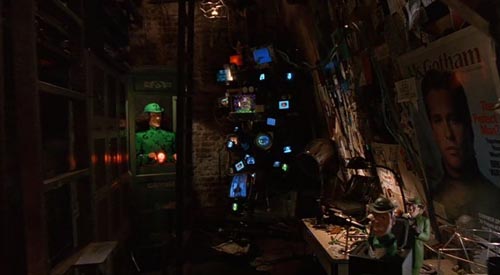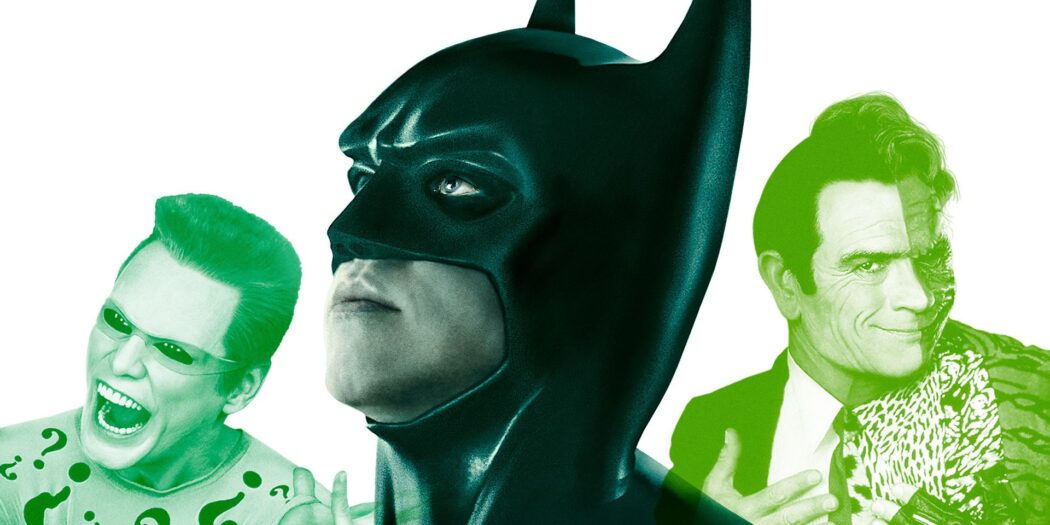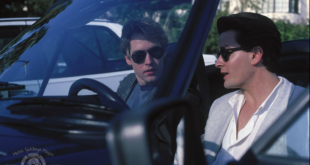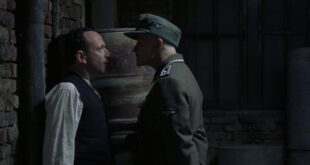“I always hated those titles like Batman Forever. That sounds like a tattoo that somebody would get when they’re on drugs or something. Or something some kid would write in the yearbook.”
—Producer Tim Burton
Batman Forever can be considered the first truly nineties Batman picture. It was released right in the middle of the decade in 1995. After two dark and bizarre (and visionary) Batman films from Tim Burton, we got two light and strange (and yes, visionary) Batman films from Joel Schumacher, a journeyman director with eclectic and varied filmography. I was only 6, but I remember the tremendous marketing impact the Batman films had. I was Batman several times for Halloween as a boy. This is probably what I most associate with Batman as a boy, along with the Keaton original. I’m not here to make the case that Batman Forever is some misunderstood masterpiece. Still, in revisiting the film multiple times in recent years, I’ve been fascinated by how I’ve come more and more to admire it as visionary blockbuster filmmaking, flaws and all. I’m not here to hold up the film as a work of logic or defend the screenplay as coherent, it’s not that, and this world is pure and total fantasy, so I’m ok with that.

Joel Schumacher’s Batman films do not have a good reputation, and honestly, most of that is geared towards the disaster that 1997’s Batman & Robin was, which went too far in the opposite direction. This is not a review of that movie, but what comes before and after Batman Forever needs to be mentioned. Batman Forever is far from heralded, though, with a 39% critically on Rotten Tomatoes and an even lower 32% fan score. The film is considered the downward trend of Batman movies, which nearly killed the franchise until resurrected by Christopher Nolan in 2005. Batman Forever is often called loud, boring, ridiculous, over-the-top, and excessively busy. I agree with all these charges except boring. The film is rarely ever dull and always interesting to look at.
Besides some outdated CGI, I’m surprised by how well this film has displayed visually. Visually, the film is not a retread of Burton’s gothic look or even the fabulous look of the animated series; it uses bright colors and neon pop lighting to illustrate the mad hysteria that Gotham is currently under. Barbara Ling’s production design is flawless and original. Schumacher was looking for a design with no connections to the previous films and was inspired instead by the images from the Batman comic books seen in the 40s and 50s and New York City architecture in the 30s.
Batman Forever Concept Art: Gotham City. Production Design by Barbara Ling. #ReleaseTheSchumacherCut pic.twitter.com/xmplmnz2W7
— RTSchumacherCut 💚 (@CutSchumacher) December 13, 2020
The result is a highly original look that stands out from the previous two Batman films or any made since. Created through practical visual effects and early use of CGI, the film is always interesting to watch. It’s funny because I have watched this movie a few times with the muted volume, but what stands out when you watch it that way is the visual storytelling. Schumacher is very adept at bringing a visually exciting world to the screen. There’s a distinctive 90s MTV look to it, and I do not mean that negatively. MTV is responsible for exciting visual and editing methods, and Batman Forever came out in the heart of the 90s. The film is alive and eye-catching in ways that Burton’s films could only dream of. More eye-catching than Christopher Nolan’s rather bland but fitting for his vision of the story of Gotham.
Alright, so visually, the film is a gem. What about the rest? Well, the performances in the film are varied and interesting. Val Kilmer, who was difficult to deal with on set, is fine as Bruce Wayne/Batman and credits this film for at least making Bruce and his trauma a tad more front and center compared, especially to Batman Returns, where Bruce Wayne feels like a supporting character. Not that Batman Forever is a Batman character study, though. The two main villains Two-Face (Tommy Lee Jones) and The Riddler (Jim Carrey), take center stage in two of the wildest, most over-the-top performances I can remember.

Both performances have a sinister undertone, especially Carrey early on as Nygma, whose transformation from oddball Wayne Enterprise scientist to Riddler we see in rather impressive terms, compelling, funny, and sinister. Many will say Carrey goes too over the top, but I also think there’s a chilling subtext underneath that never gets lost. I think it’s a brilliant performance that overshadows Tommy Lee Jones as Two-Face. It’s not a Two-Face origin story, though. He’s already that when we meet him in the opening credits. Carrey gets more of an opportunity to shine because he has an arc to work with. The actors did not get along, and Tommy Lee Jones hated Jim Carrey because, according to him, he was just a buffoon, but Carrey proved him wrong, and his performance as Nygma is definitely one of the highlights.
I will defend the performances in the film always. While they’re over the top, each character has some pain underneath that they can express subtly at times throughout the film. Nicole Kidman is also wonderfully horny as Dr. Chase Meridian, adding to the fun fetishistic nature of Batman. There’s something coldly detached but oddly compelling about Kilmer and Kidman’s performances. One of the positive aspects of their performances and the way the film is written is that we get an actual examination of Batman. There’s genuine interest, not just in the Wayne murders, but also in why this boy became Batman. Why he became who he is. A lot more than Batman and Batman Returns, we get a Bruce Wayne who, for the first time, is genuinely trying to wrestle with his traumatic past and why he is who he is.

It’s funny because this film is often called bland. Still, many things are going on besides the main plot of Nygma and brain waves, which itself is pretty fascinating because Nygma is trying to offer an escape from what he feels is a dreary life, perfectly encapsulated by his wonderfully pathetic Gotham apartment in what is perhaps my favorite production design moment of the film. He becomes evil after Bruce rejects his invention, and Bruce rightly predicts that Nygmatech will be used adversely. As bizarre as the whole brainwave plot is, it also makes sense in terms of today. VR has taken on a genuine new meaning to everyday life, and it often seems people would instead escape artificially than be able to afford to actually. Nygma is your classic villain who wants to use technology to become more intelligent and powerful, almost like Mark Zuckerberg or Elon Musk.
If you’re still against Batman Forever, I advise you to give it a chance! There are many positive qualities to the film, and yes, while it did lead to Batman & Robin stands on its own as a damn fine original piece of superhero filmmaking. Did I forget to mention the soundtrack is fantastic!! U2’s Hold Me, Thrill Me, Kiss Me, Kill Me, and Seal’s Kiss From a Rose. Not to mention Elliot Goldenthal’s score. It takes me right back to being a kid again. Batman Forever had a tremendous impact on me and many kids of my era’s Batman fandom, and I believe it’s a quality Batman film and film in its own right.

 Movie Finatics The Place for Movie Lovers
Movie Finatics The Place for Movie Lovers




